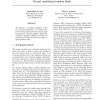508 search results - page 66 / 102 » A graphical model for protein secondary structure prediction |
CSB
2004
IEEE
14 years 28 days ago
2004
IEEE
Proteases play a fundamental role in the control of intra- and extracellular processes by binding and cleaving specific amino acid sequences. Identifying these targets is extremel...
ESWA
2006
13 years 9 months ago
2006
In recent years, there have been many studies focusing on improving the accuracy of prediction of transmembrane segments, and many significant results have been achieved. In spite...
BMCBI
2004
13 years 9 months ago
2004
Background: We establish that the occurrence of protein folds among genomes can be accurately described with a Weibull function. Systems which exhibit Weibull character can be int...
JMLR
2010
13 years 4 months ago
2010
We propose a non-linear graphical model for structured prediction. It combines the power of deep neural networks to extract high level features with the graphical framework of Mar...
BMCBI
2007
13 years 9 months ago
2007
Background: We examine the accuracy of enzyme catalytic residue predictions from a network representation of protein structure. In this model, amino acid α-carbons specify vertic...

